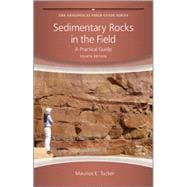
Note: Supplemental materials are not guaranteed with Rental or Used book purchases.
Purchase Benefits
What is included with this book?
Maurice Edwin Tucker is a leading British sedimentologist, specialising in the field of carbonate sedimentology, more commonly known as limestones. From 1993 to 2011 he held the position of Professor of Geological Sciences at the University of Durham, and from 1998 to 2011 was Master of University College, Durham.
Acknowledgements.
1 Introduction.
1.1 Tools of the Trade.
1.2 Other Tools for the Field.
1.3 Use of GPS (Global Positioning System) in Sedimentary Studies.
1.4 Safety in the Field and General Guidance for Fieldwork.
2 Field Techniques.
2.1 What to Look For.
2.2 The Approach.
2.3 Field Notes.
2.4 Graphic Logs.
2.5 The Logging of Cores.
2.6 Lithofacies Codes.
2.7 Collecting Specimens.
2.8 Presentation of Results.
2.9 The Way-Up of Sedimentary Strata.
2.10 Stratigraphic Practice.
3 Sedimentary Rock Types.
3.1 Principal Lithological Groups.
3.2 Sandstones.
3.3 Conglomerates and Breccias.
3.4 Mudrocks.
3.5 Limestones.
3.6 Evaporites.
3.7 Ironstones.
3.8 Cherts.
3.9 Phosphate Deposits (Phosphorites).
3.10 Organic-Rich Deposits.
3.11 Volcaniclastic Deposits.
4 Sedimentary Rock Texture.
4.1 Introduction.
4.2 Sediment Grain-Size and Sorting.
4.3 Grain Morphology.
4.4 Sediment Fabric.
4.5 Textural Maturity.
4.6 Texture of Conglomerates and Breccias.
4.7 Induration and Degree of Weathering.
4.8 Colour of Sedimentary Rocks.
5 Sedimentary Structures and Geometry of Sedimentary Deposits.
5.1 Introduction.
5.2 Erosional Structures.
5.3 Depositional Structures.
5.4 Depositional Structures of Limestones (Including Dolomites).
5.5 Post-Depositional Sedimentary Structures.
5.6 Biogenic Sedimentary Structures.
5.7 The Geometry of Sedimentary Deposits and Lateral Facies Changes.
6 Fossils in the Field.
6.1 Introduction.
6.2 Fossil Distribution and Occurrence.
6.3 Fossil Associations and Diversity.
6.4 Skeletal Preservation (Taphonomy) and Diagenesis.
7 Palaeocurrent Analysis.
7.1 Introduction.
7.2 Palaeocurrent Measurements.
7.3 Structures for Palaeocurrent Measurement.
7.4 Presentation of Results and Calculation of Vector Means.
7.5 Interpretation of the Palaeocurrent Pattern.
8 What Next? Facies Identification and Sequence Analysis.
8.1 Introduction.
8.2 Facies Analysis.
8.3 Facies, Facies Models and Depositional Environments.
8.4 Cycle Stratigraphy and Sequence Stratigraphy.
Recommended Reading.
Index.
The New copy of this book will include any supplemental materials advertised. Please check the title of the book to determine if it should include any access cards, study guides, lab manuals, CDs, etc.
The Used, Rental and eBook copies of this book are not guaranteed to include any supplemental materials. Typically, only the book itself is included. This is true even if the title states it includes any access cards, study guides, lab manuals, CDs, etc.